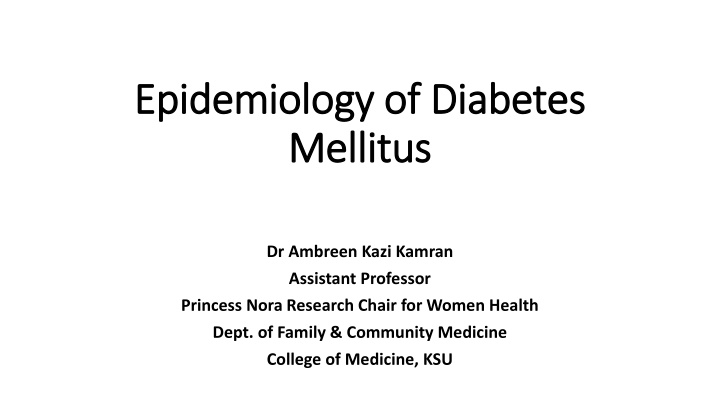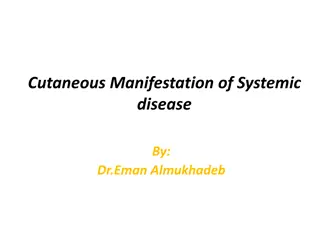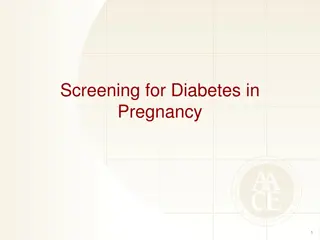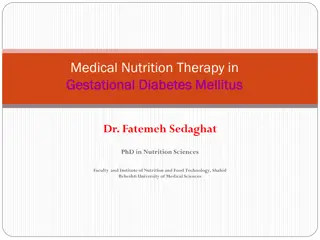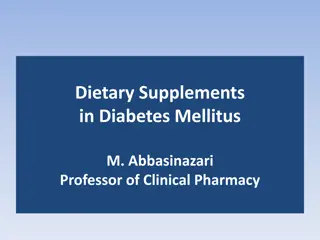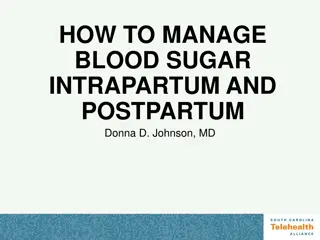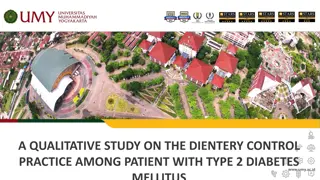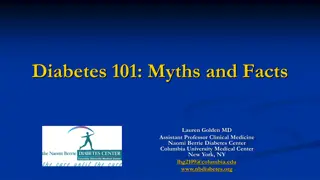Overview of Diabetes Mellitus: Types, Diagnosis, and Epidemiology
Diabetes Mellitus is a metabolic disorder characterized by chronic hyperglycemia. It includes Type 1, Type 2, Gestational, Secondary, and Pre-diabetes. Diagnosis involves symptoms like thirst, frequent urination, and weight loss, along with specific glucose tests. Understanding the types, diagnostic criteria, and risk factors is crucial for estimating prevalence and managing complications of diabetes.
Download Presentation

Please find below an Image/Link to download the presentation.
The content on the website is provided AS IS for your information and personal use only. It may not be sold, licensed, or shared on other websites without obtaining consent from the author.If you encounter any issues during the download, it is possible that the publisher has removed the file from their server.
You are allowed to download the files provided on this website for personal or commercial use, subject to the condition that they are used lawfully. All files are the property of their respective owners.
The content on the website is provided AS IS for your information and personal use only. It may not be sold, licensed, or shared on other websites without obtaining consent from the author.
E N D
Presentation Transcript
Epidemiology of Diabetes Epidemiology of Diabetes Mellitus Mellitus Dr Ambreen Kazi Kamran Assistant Professor Princess Nora Research Chair for Women Health Dept. of Family & Community Medicine College of Medicine, KSU
Objectives Objectives To list the types of Diabetes Mellitus To describe the prevalence of Diabetes Mellitus To recognize the importance of diagnostic criteria for estimating the prevalence of diabetes mellitus To discuss the risk factors and complications of type II diabetes mellitus
Definition Definition A metabolic disorder of multiple aetiology characterized by chronic hyperglycaemia with disturbances of carbohydrate, fat and protein metabolism resulting from defects in insulin secretion, insulin action or both
Types of diabetes Types of diabetes Type 1: sudden onset absolute deficiency in insulin. Usually affects younger age group (not always) Type 2: gradual onset of relative insulin insensitivity. Usually older age group (not always) Gestational diabetes: Gestational diabetes mellitus (GDM) is defined as any degree of glucose intolerance with onset or first recognition during pregnancy
Types of diabetes Types of diabetes Secondary diabetes: The diabetes is not the main illness, a secondary condition that results because of the main illness. If it is possible to treat the main illness successfully the diabetes may/will disappear e.g. cystic fibrosis, chronic pancreatitis, infections. Pre-diabetes: Impaired glucose tolerance A person with pre- diabetes has a blood sugar level higher than normal, but not high enough for a diagnosis of diabetes; & is at higher risk for developing type 2 diabetes. May remain undiagnosed for years; risk of complications same as for T2DM
Diagnosis Diagnosis Thirst Passing lots of urine Malaise Infections (thrush) Weight loss Diagnosis: Random plasma glucose Fasting plasma glucose Oral glucose tolerance test 2h glucose
. Diagnosis Diagnosis 1. Symptoms of diabetes plus casual plasma glucose concentration 200 mg/dl (11.1 mmol/l). Casual is defined as any time of day without regard to time since last meal. The classic symptoms of diabetes include polyuria, polydipsia, and unexplained weight loss. OR 2. FPG 126 mg/dl (7.0 mmol/l). Fasting is defined as no caloric intake for at least 8 h. OR 3. 2-h postload glucose 200 mg/dl (11.1 mmol/l) during an OGTT. The test should be performed as described by WHO, using a glucose load containing the equivalent of 75 gms glucose dissolved in water. Ref: Diagnosis and Classification of Diabetes Mellitus American Diabetes Association Diabetes Care 2006 Jan; 29(suppl 1): s43-s48
Diagnosis Diagnosis The corresponding categories when the OGTT is used are the following: 2-h postload glucose <140 mg/dl (7.8 mmol/l) = normal glucose tolerance; 2-h postload glucose 140 199 mg/dl (7.8 11.1 mmol/l) = IGT (impaired glucose tolerance); 2-h postload glucose 200 mg/dl (11.1 mmol/l) = provisional diagnosis of diabetes (the diagnosis must be confirmed)
Diagnosis Diagnosis The International committee on DM, recognized an intermediate group of subjects whose glucose levels, although not meeting criteria for diabetes, are nevertheless too high to be considered normal. The categories of FPG values are as follows: FPG <100 mg/dl (5.6 mmol/l) = normal fasting glucose; FPG 100 125 mg/dl (5.6 6.9 mmol/l) = IFG (impaired fasting glucose); FPG 126 mg/dl (7.0 mmol/l) = provisional diagnosis of diabetes (the diagnosis must be confirmed)
Why is diabetes so important? Why is diabetes so important? The burden to patients and the family Burden for the health system Complications Cardiovascular Eyes Renal - Hypertension, renal failure Feet and Skin infections, sexual, psycho-sexual, depression Quality of life Premature mortality
Global Prevalence of Diabetes Global Prevalence of Diabetes Prevalence worldwide is increasing 2.8% in 2000;4.4% in 2030 worldwide (171 million in 2000; 366 million in 2030) DM worldwide was already 366 million by 2011 The prevalence increased to 382 millions (8.2%) by 2013 There is a large % that is undiagnosed as well as a large % at high risk of developing DM A huge percentage of the reported diabetics are in the 40- 59 age group, among whom 80% live in countries with low and middle-income economies
Global Prevalence of Diabetes Global Prevalence of Diabetes In 2013, about half of all diabetes-related deaths in adults were in the age group below 60 years. Every six seconds there is a diabetes-related death and in the more poorly-developed regions 35 out of 219 countries [16% of the total] show very high prevalence of diabetes, more than 12% These countries fall mainly in the regions of the Western Pacific, North Africa and Middle East
Estimated prevalence and number of people with diabetes (adults 18+ years) Source, WHO 2016
Regional and local prevalence Regional and local prevalence Six of the top ten countries having the highest prevalence rates of diabetes globally are found in the Gulf region, viz., Kuwait, Lebanon, Qatar, Bahrain, UAE and Saudi Arabia Bahrain 15.4%; Kuwait 14.6%; UAE 18.7%; Qatar 15.4% There are 20 Arab countries in which nearly 20.5 million people are living with diabetes and another 13.7 million are in the pre-diabetes stage, with Impaired Glucose Tolerance (IGT) The number of deaths attributed to diabetes in Saudi Arabia is about 170,000 adults, which is greater than 10% of all deaths in the country
Diabetes prevalence (% of population ages 20 to 79) Rank Country % Year 1 Tuvalu 27.25 2017 2 Nauru 24.07 2017 3 New Caledonia 23.36 2017 4 Kiribati 22.66 2017 5 Mauritius 22.02 2017 6 Solomon Islands 18.68 2017 7 Saudi Arabia 17.72 2017 8 Papua New Guinea 17.65 2017 9 Egypt 17.31 2017 10 United Arab Emirates 17.26 2017
High blood glucose age-standardized mortality rates per 100000 by WHO region, age 20+, 2012 Source, WHO 2016
Trends in prevalence of diabetes, 19802014, by WHO region Source, WHO 2016
Percentage of all deaths attributable to high blood glucose for adults aged 2069 years, by WHO region and sex, 2000 and 2012 Source, WHO 2016
Percentage of all-cause deaths globally attributed to high blood glucose in men, 2012 Source, WHO 2016
Percentage of all-cause deaths globally attributed to high blood glucose in women, 2012 Source, WHO 2016
Trends in prevalence of diabetes, 19802014, by country income group Source, WHO 2016
Diabetes Diabetes Mellitus and KSA Mellitus and KSA WHO ranks SA second in the prevalence of diabetes in the Middle East region KSA has reached a point where DM is considered an epidemic A more recent study reported that the prevalence of diabetes had risen to 34.1% in males and 27.6% in females. The mean reported age for diabetes onset in males and females was 57.5 and 53.4 years, respectively
Diabetes Diabetes - - an escalating problem an escalating problem in the Kingdom of Saudi in the Kingdom of Saudi Arabia Arabia Bacchus & Madkour 1982 2.5% (age >15) 1987 4.3% Fatani 1992 4.6% AbuZaid 1996 9.5% (age >14 years) Hazmi 1997 17% (age >30 years) Nuaim 2004 24% (age >30 years) Nozha 2014 25% (age >30 years) MOH
Trends in age-standardized prevalence of diabetes in Saudi Arabia WHO Diabetes country profiles, 2016.
Diabetes mellitus and KSA Diabetes mellitus and KSA The overall prevalence of DM in Saudi Arabia, and especially in the central region (Riyadh), was 23.7% (age group 30-70 years), while another 14.1% had IFG The incidence of diabetes was significantly higher in the urban regions (25.5% vs 19.5% in the rural areas) The incidence of T1DM is on the increase over the last 30 years The prevalence of T1DM among the Saudi children and adolescents is 109.5 per 100,000
Complications Complications Diabetes accounts for more than 5% of the global deaths, which are mostly due to CVD Diabetes is responsible for over one third of end- stage renal disease requiring dialysis Amputations are at least 10 times more common in people with diabetes A leading cause of blindness & visual impairment Diabetics are 20 times more likely to develop blindness than non-diabetics
Risk Risk factors factors Risk factors for Type 2 DM are complex including -obesity -Genetics - Life style factors (overfeeding and sedentary life) - There are patho-physiological changes (weight gain insulin resistance and reduction of insulin secretion) may lead to glucose intolerance and diabetes - Important factors are physical inactivity, dietary imbalance and infections
Risk factors Risk factors Autoimmune disease and viral infections may be risk factors for TIDM Physiologic or emotional stress: causes prolonged elevation of stress hormone epinephrine, glucagon and growth hormone), which raises blood glucose levels Pregnancy as predisposing factor causes weight gain and increases levels of estrogen and placental hormones, which antagonize insulin Medications that are known to antagonize the effects of insulin: thiazide diuretics, adrenal corticosteroids, oral contraceptives levels (cortisol,
Future Directions Future Directions Tackling environmental factors and lifestyle Appropriate use of screening tools to control diabetes mellitus Early interventions in high risk populations Therapeutic and management choices and updated criteria for treatment Rehabilitation services for complications
References References 1. Al Dawish MA, Robert AA, Braham R, Al Hayek AA, Al Saeed A, Ahmed RA, Al Sabaan FS. Diabetes Mellitus in Saudi Arabia: A Review of the Recent Literature. Curr Diabetes Rev. 2016;12(4):359-368. Review. 2. Asirvatham Alwin Robert , Abdulrahman Al-Dawish, Muhammad Mujammami,and Mohamed Abdulaziz Al Dawish. Type 1 Diabetes Mellitus in Saudi Arabia: A Soaring Epidemic. International Journal of Pediatrics Volume 2018, Article ID 9408370, 9 pages https://doi.org/10.1155/2018/9408370 3. Zahid Naeem. Burden of Diabetes Mellitus in Saudi Arabia. International Journal of Health Sciences, Qassim University, Vol. 9, No. 3 (July-Sept 2015)
